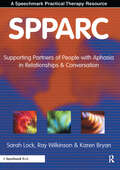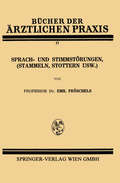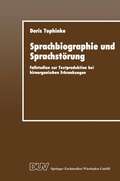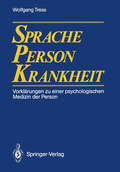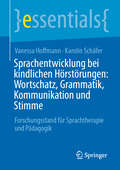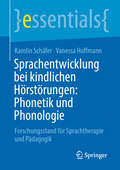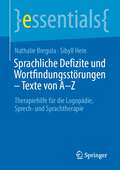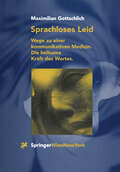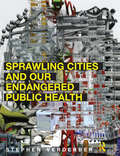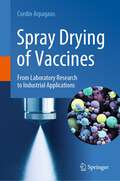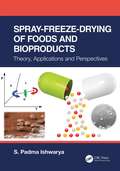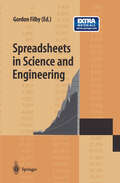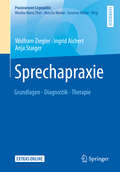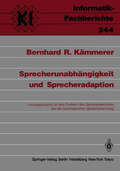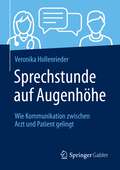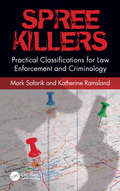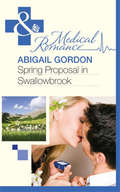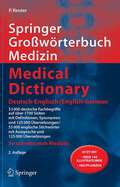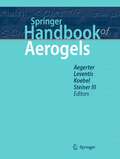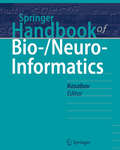- Table View
- List View
SPPARC: Supporting Partners of People with Aphasia in Relationships and Conversation
by Karen Bryan Ray Wilkinson Sarah Lock"SPPARC" highlights the importance of working with partners in order to create real life change both for partners and for people with aphasia. "The SPPARC" pack consists of a manual, CD Rom and DVD and provides: practical resources to run, support and conversation training programmes either for groups of partners or for the partner and the person with aphasia together as a couple; conversation assessment and treatment materials, photocopiable and printable (from the CD Rom) activities and handouts, as well as an introduction to conversational analysis; and, a DVD with 27 extracts of everyday conversations between several people with aphasia and their partners, which can be used as a resource both for assessing everyday conversation and for facilitating change.Theoretically validated through the 'Coping with Communicating' research project from University College London, "SPPARC" goes beyond the theory and provides a complete resource of clinically effective tools to work with people with aphasia and their communication partners.
Sprachbiographie und Sprachstörung: Fallstudien zur Textproduktion bei hirnorganischen Erkrankungen (DUV Sozialwissenschaft)
by Doris TophinkeWer als Sprachwissenschaftler ein Gespräch mit sprachgestörten Personen führt. stellt unmittelbar fest, wie irritierend und herausfordernd dieses Phänomen ist. Das Erzählen ist verändert. die Persönlichkeit des Sprechers und die Form. in der er erzählt. stimmen nicht überein. das Erzählen hat aber nach wie vor keine zufällige Form. Die Interaktion ist konfliktreich. droht zusammenzubrechen. aber sie ist, von extremen Fällen abgesehen. möglich. Einige der Schwierigkeiten. die auftreten. Wortfindungsstörungen. lexikalische Fehlwahlen u.ä.. sind einem selbst nicht unbekannt. Man hat sie schon an sich selbst erlebt und auf Befindlichkeiten wie Müdigkeit oder Streßzurückgeführt; jetzt stehen sie aufgrund der als ursächlich angesetzten hirnorganischen Erkrankung in einem pathologischen Kontext. In dieser unmittelbaren Erfahrung erscheint vieles verändert. doch entzieht es sich einer eindeutigen Bestimmung. Kategorien wie "pathologisch" und "nicht pathologisch" greifen allenfalls im Hinblick auf die medizinisch diagnosti zierte Erkrankung. Aphasiologie und Neurolinguistik definieren die Sprachstörungen mittels experimentell-quantitativer. naturwissenschaftlich orientierter Analyseverfah ren. Auf diese Weise erreichen sie eine eindeutige Grenzziehung zwischen dem Pathologischen und dem Nichtpathologischen. Doch umgehen sie die Ebene der Alltagserfahrung. Das Phänomen "Sprachstörunq" interessiert vor allem und zuallererst in der Perspektive auf das Sprachsystem. Es geht um die Bestimmung sprachsystematischer Störungen. Alle weiteren Frage stellungen sind nachgeordnete Anschlußfragestellungen.
Sprache — Person — Krankheit: Vorklärungen zu einer psychologischen Medizin der Person
by Wolfgang TressSprachentwicklung: Entwicklung – Diagnostik – Förderung im Kleinkind- und Vorschulalter
by Tamara LautenschlägerDieses Lehrbuch bietet einen kompakten Gesamtüberblick über das aktuelle Wissen zum Thema Sprachentwicklung, Sprachdiagnostik und Sprachförderung. Der Fokus liegt auf dem Kleinkind- und Vorschulalter. Die Themen des Buches umfassen die Grundlagen und spezifische Aspekte der Sprachentwicklung bei ein- und mehrsprachig aufwachsenden Kindern. Es werden Auffälligkeiten im Spracherwerb und deren Diagnostik, auch in Verbindung zu anderen Entwicklungsbereichen, sowie Möglichkeiten zur Förderung und Therapie sprachlicher Fähigkeiten in verschiedenen Kontexten dargestellt. Alle Kapitel sind einheitlich strukturiert, von erfahrenen Expert*innen aus Wissenschaft, Lehre und Praxis theoretisch fundiert und anschaulich verfasst. Sie enthalten neben aktuellen Studienergebnissen zu zentralen Inhalten auch konkrete Anwendungsmöglichkeiten und Fallbeispiele.
Sprachentwicklung bei kindlichen Hörstörungen: Forschungsstand für Sprachtherapie und Pädagogik (essentials)
by Vanessa Hoffmann Karolin SchäferDas Buch betrachtet die Entwicklungsbereiche Semantik / Lexikon, Syntax/ Morphologie, Pragmatik/Kommunikation und Stimme bei Kindern mit Hörschädigung. Es gibt einen Überblick über den aktuellen Forschungsstand zum Wortschatz- und Grammatikerwerb, den kommunikativ-pragmatische Fähigkeiten, insbesondere Theory of Mind, sowie zur Stimmgebung und Stimmqualität.
Sprachentwicklung bei kindlichen Hörstörungen: Forschungsstand für Sprachtherapie und Pädagogik (essentials)
by Karolin Schäfer Vanessa HoffmannDas Buch bietet einen zusammenfassenden Überblick über die reguläre vorsprachliche Kommunikationsentwicklung sowie Sprach- und Sprechentwicklung guthörender Kinder im Vergleich zu möglichen Besonderheiten bei Kindern mit peripherer Hörstörung. Dabei werden insbesondere die Entwicklungsbereiche Phonetik und Phonologie in den Vordergrund gestellt, so dass sich letztendlich ein Überblick über den aktuellen Forschungsstand zu den Bereichen Lauterwerb, Phonemerwerb, Erwerb von Silbenstruktur und Konsonantenverbindungen sowie Phonologische Prozesse ergibt.
Sprachliche Defizite und Wortfindungsstörungen – Texte von A-Z: Therapiehilfe für die Logopädie, Sprech- und Sprachtherapie (essentials)
by Nathalie Bregula Sibyll HeinDieses essential bietet eine Sammlung humorvoller Geschichten für die Behandlung verschiedener sprachlicher Defizite in der Logopädie und Sprachtherapie, mit Schwerpunkt auf Aussprache- und Wortfindungsstörungen, z.B. Lese- und Rechtschreibstörungen, eingeschränkte Erzählfähigkeit, phonetische und phonologische Störungen, Aphasien und den dazugehörigen Wortfindungsstörungen, sowie für Sprachstörungen bei Demenz oder Parkinson. Die Texte eignen sich für die Textebene und den Transfer in die Spontansprache und trainieren den aktiven und passiven Wortschatz. Fragen am Ende der Geschichte üben das Wort- und Textverständnis und gleichzeitig fördern sie die Erzählfähigkeit.
Sprachloses Leid: Wege zu einer kommunikativen Medizin. Die heilsame Kraft des Wortes
by Maximilian GottschlichDie moderne Medizin ist reich an wissenschaftlich-technischen Leistungen, aber arm an menschlichen, kommunikativen Beziehungen. Immer mehr Patienten klagen über ein gefühlloses, inhumanes Medizinsystem, das auf ihre subjektiven seelischen Bedürfnisse keine Rücksicht nimmt und dem die Sprache des Leids fremd ist. Aber auch immer mehr Ärzte leiden unter der Kommunikationsarmut dieses unpersönlichen Medizinbetriebes. Zentrale Herausforderung der modernen Medizin für die Zukunft wird es sein, eine neue Kommunikationskultur entwickeln zu müssen, um den Menschen in der Ganzheit seiner seelischen, geistigen, emotionalen und körperlichen Beziehungen verstehen und respektieren zu lernen. Vor dem Hintergrund einer ausführlichen Defizitanalyse der gestörten Beziehungen zwischen Arzt und Patient wird versucht, dem grundlegenden Zusammenhang von Kommunikation und Heilen nachzugehen und zukunftsweisende Perspektiven einer heilsamen medizinischen Kommunikation zu entwerfen.
Sprachwirkung: Psychophysiologische Forschungsgrundlagen und ausgewählte Experimente (Beiträge zur psychologischen Forschung #6)
by Gerd KegelSprawling Cities and Our Endangered Public Health
by Stephen VerderberSprawl is an unsustainable pattern of growth that threatens to undermine the health of communities globally. It has been a dominant mid-to-late twentieth century growth pattern in developed countries and in the twenty-first century has shown widespread signs of proliferation in India, China, and other growing countries. The World Health Organization cites sprawl for its serious adverse public health consequences for humans and ecological habitats. The many adverse impacts of sprawl on the health of individuals, communities, and biological ecosystems are well documented. Architects have been rightly criticized for failing to grasp the aesthetic and functional challenge to create buildings and places that mitigate sprawl while simultaneously promoting healthier, active lifestyles in neighbourhoods and communities. Sprawling Cities and Our Endangered Public Health examines the past and present role of architecture in relation to the public health consequences of unmitigated sprawl and the ways in which it threatens our future. Topics examined include the role of twentieth century theories of architecture and urbanism and their public health ramifications, examples of current unsustainable practices, design considerations for the creation of health-promoting architecture and landscape urbanism, a critique of recent case studies of sustainable alternatives to unchecked sprawl, and prognostications for the future. Architects, public health professionals, landscape architects, town planners, and a broad range of policy specialists will be able to apply the methods and tools presented here to counter unmitigated sprawl and to create architecture that promotes active, healthier lifestyles. Stephen Verderber is an internationally respected evidence-based researcher/practitioner/educator in the emerging, interdisciplinary field of architecture, health, and society. This, his latest book on the interactions between our buildings, our cities and our health, is an invaluable reference source for everyone concerned with sustainable architecture and landscape urbanism.
Sprawling Cities and Our Endangered Public Health
by Stephen VerderberSprawl is an unsustainable pattern of growth that threatens to undermine the health of communities globally. It has been a dominant mid-to-late twentieth century growth pattern in developed countries and in the twenty-first century has shown widespread signs of proliferation in India, China, and other growing countries. The World Health Organization cites sprawl for its serious adverse public health consequences for humans and ecological habitats. The many adverse impacts of sprawl on the health of individuals, communities, and biological ecosystems are well documented. Architects have been rightly criticized for failing to grasp the aesthetic and functional challenge to create buildings and places that mitigate sprawl while simultaneously promoting healthier, active lifestyles in neighbourhoods and communities. Sprawling Cities and Our Endangered Public Health examines the past and present role of architecture in relation to the public health consequences of unmitigated sprawl and the ways in which it threatens our future. Topics examined include the role of twentieth century theories of architecture and urbanism and their public health ramifications, examples of current unsustainable practices, design considerations for the creation of health-promoting architecture and landscape urbanism, a critique of recent case studies of sustainable alternatives to unchecked sprawl, and prognostications for the future. Architects, public health professionals, landscape architects, town planners, and a broad range of policy specialists will be able to apply the methods and tools presented here to counter unmitigated sprawl and to create architecture that promotes active, healthier lifestyles. Stephen Verderber is an internationally respected evidence-based researcher/practitioner/educator in the emerging, interdisciplinary field of architecture, health, and society. This, his latest book on the interactions between our buildings, our cities and our health, is an invaluable reference source for everyone concerned with sustainable architecture and landscape urbanism.
Spray Drying of Vaccines: From Laboratory Research to Industrial Applications
by Cordin ArpagausThis book addresses the stabilization of vaccine powders by spray drying and provides an overview of the current state of the art on a laboratory and industrial scale. The book aims to familiarize readers with the advances in vaccine spray drying technology to understand its application potential better. In particular, the book addresses the design of aseptic spray dryers, parameters affecting the spray drying process, sterile powder processing, cleaning procedures, and powder filling. In addition, different drying technologies for the production of dry powder vaccines are compared to discuss the unique capabilities of spray drying as a particle technology for vaccines. Special attention is given to research studies on spray-dried vaccines published over the past 30 years, with key findings from laboratory research to clinical trials. Potential applications of spray-dried vaccines and routes of administration are presented in detail. Finally, an outlook is given on how close the aseptic spray-drying of vaccines is to the market and the challenges that need to be overcome to be commercially successful. The book's target audience is academics, researchers, vaccine developers, industry experts, students, and possibly funders, including government agencies, who are active in the field. In addition, the book is a reference source for those involved in the vaccine formulation and biopharmaceutical processing industry.
Spray-Freeze-Drying of Foods and Bioproducts: Theory, Applications and Perspectives
by S. Padma IshwaryaSpray-freeze-drying (SFD) is a synergistic drying technology that imbibes in it the merits of both spray drying and freeze-drying, whilst overcoming the limitations of these predecessor technologies. SFD produces uniquely powdered food and pharmaceutical products with porous microstructure and superior quality attributes. Owing to its atomization step and ultra-low-temperature operation, SFD is a competent drying technique for the production of valuable but sensitive bioactive components. Despite the costs and complexities involved, SFD has a competitive edge over the conventional drying techniques in providing distinctive product attributes. The applications of spray-freeze-drying in the area of food and bioproducts span across the product categories of instant food powders, dry flavors, active pharmaceutical ingredients, poorly water-soluble drugs, probiotics, proteins, enzymes and vaccines. Spray-Freeze-Drying of Foods and Bioproducts: Theory, Applications and Perspectives is the first exclusive title on this interesting drying technique. It provides a comprehensive understanding of the fundamentals of SFD and its food and pharmaceutical applications. The scope of this book, comprising 12 chapters, has been organizedunder four major headings: fundamentals of process-stages, applications with case-studies, recent advancements and the processing bottlenecks and solutions. Key Features Provides examples and case studies of nuances and intricacies associated with each stage of the spray-freeze-drying process Highlights the applications of spray-freeze-drying in the production of food products including soluble coffee, dairy powders, probiotics and flavors Serves as a ready-reckoner of characterization methods for spray-freeze-dried products Contains 200+ illustrations and tabulations The contents of this book are organized to cater to the knowledge needs of students, academicians, researchers and professionals in the food and pharmaceutical industry.
Spray-Freeze-Drying of Foods and Bioproducts: Theory, Applications and Perspectives
by S. Padma IshwaryaSpray-freeze-drying (SFD) is a synergistic drying technology that imbibes in it the merits of both spray drying and freeze-drying, whilst overcoming the limitations of these predecessor technologies. SFD produces uniquely powdered food and pharmaceutical products with porous microstructure and superior quality attributes. Owing to its atomization step and ultra-low-temperature operation, SFD is a competent drying technique for the production of valuable but sensitive bioactive components. Despite the costs and complexities involved, SFD has a competitive edge over the conventional drying techniques in providing distinctive product attributes. The applications of spray-freeze-drying in the area of food and bioproducts span across the product categories of instant food powders, dry flavors, active pharmaceutical ingredients, poorly water-soluble drugs, probiotics, proteins, enzymes and vaccines. Spray-Freeze-Drying of Foods and Bioproducts: Theory, Applications and Perspectives is the first exclusive title on this interesting drying technique. It provides a comprehensive understanding of the fundamentals of SFD and its food and pharmaceutical applications. The scope of this book, comprising 12 chapters, has been organizedunder four major headings: fundamentals of process-stages, applications with case-studies, recent advancements and the processing bottlenecks and solutions. Key Features Provides examples and case studies of nuances and intricacies associated with each stage of the spray-freeze-drying process Highlights the applications of spray-freeze-drying in the production of food products including soluble coffee, dairy powders, probiotics and flavors Serves as a ready-reckoner of characterization methods for spray-freeze-dried products Contains 200+ illustrations and tabulations The contents of this book are organized to cater to the knowledge needs of students, academicians, researchers and professionals in the food and pharmaceutical industry.
Spreadsheets in Science and Engineering
by Gordon Filby"Spreadsheets in Science and Engineering" shows scientists and engineers at all levels how to analyze, validate and calculate data and how the analytical and graphic capabilities of spreadsheet programs (ExcelR) can solve these tasks in their daily work. The examples on the CD-ROM accompanying the book include material of undergraduate to current research level in disciplines ranging from chemistry and chemical engineering to molecular biology and geology.
Sprechapraxie: Grundlagen - Diagnostik - Therapie (Praxiswissen Logopädie)
by Wolfram Ziegler Ingrid Aichert Anja StaigerDieses Buch aus der Reihe Praxiswissen Logopädie ist ein Brückenschlag zwischen Theorie und Praxis. Umfassendes Grundlagenwissen zur Sprechapraxie wird ergänzt durch:Hilfestellungen für die differenzialdiagnostische Abgrenzung, eine anschauliche Darstellung diagnostischer Möglichkeiten, eine umfangreiche Übersicht und kritische Reflexion bekannter Therapieansätze, Therapiebausteine und Orientierungshilfen für die Entwicklung individueller Behandlungskonzepte. Mit zahlreichen Abbildungen, praxisorientierten Tipps, weiterführende Literaturhinweise und Internetlinks sowie ein Anamnesebogen zum DownloadRenommierte Autoren transportieren verständlich und praxisnah ihr Wissen und ihre Erfahrungen mit diesem komplexen Krankheitsbild. Sie rüsten den Leser für eine gut begründete und effiziente Arbeit mit dem Patienten.
Sprecherunabhängigkeit und Sprecheradaption: Lösungsansätze für das Problem des Sprecherwechsels bei der automatischen Spracherkennung (Informatik-Fachberichte #244)
by Bernhard R. KämmererBei automatischen Spracherkennungssystemen erweist sich ein Wechsel des Sprechers als besonderes Problem: Ein zuvor durch eine andere Person trainiertes Erkennungssystem hat eine deutlich erhöhte Fehlerwahrscheinlichkeit. Das vorliegende Buch beschäftigt sich mit Lösungsmöglichkeiten, wobei Ansätze sowohl für eine sprecherunabhängige als auch für eine sprecheradaptive Erkennung entwickelt werden. Nach einer Einführung und einer Übersicht über bisherige Ansätze wird das den Untersuchungen zugrunde liegende Spracherkennungssystem vorgestellt. Ein Kapitel über die Verbesserung der sprecherunabhängigen Erkennung stellt der klassischen Methode multipler Referenzmuster neue Ansätze gegenüber. Im anschließenden Kapitel werden verschiedene sprecheradaptive Verfahren entwickelt. Aus dem Vortragen eines geeigneten Adaptionswortschatzes durch einen neuen Sprecher werden Muster gewonnen, die eine zielgerichtete Modifikation des Erkennungssystems an die geänderten Sprechcharakteristika erlauben. Für sämtliche Ansätze sowie für geeignete Verfahrenskombinationen werden experimentell bestimmte Fehlerraten angegeben, wobei das den Testläufen zugrunde gelegte Datenmaterial aussagekräftige Ergebnisse erlaubt.
Sprechstunde auf Augenhöhe: Wie Kommunikation zwischen Arzt und Patient gelingt
by Veronika HollenriederGespräche können Menschen miteinander verbinden oder auch entzweien. Egal ob zwischen Arzt und Patient, Partnern, Eltern und Kindern, Freunden oder Arbeitskollegen – jede noch so alltägliche Unterhaltung kann negative oder aber auch positive Auswirkungen auf die Gesundheit der Beteiligten haben. So können Gespräche ebenso verletzen, entmutigen und demotivieren wie auch versöhnen, Mut machen, motivieren oder trösten.Dieses Buch beleuchtet die besondere Bedeutung eines guten Arzt-Patienten-Gesprächs in der Sprechstunde - auch oder gerade, weil für Ärzte die Zeit pro Patient immer knapper wird. Die Autorin zeigt mit einem ganzheitlichen Blick, welche Rahmenbedingungen und möglichen Störfaktoren das Gespräch wechselseitig beeinflussen und wie sich gelungene Kommunikation auf das körperliche und geistige Wohlbefinden auswirkt. Konkrete Beispiele veranschaulichen, wie Arzt und Patient zu einem guten Austausch auf Augenhöhe kommen und somit bereits das Gespräch Teil der Medikation und des Heilungsprozesses werden kann.Eine Lektüre für alle, die erfahren möchten, wie das persönliche und direkte Gespräch zu einem Medikament ohne Nebenwirkungen werden kann.
Spree Killers: Practical Classifications for Criminology and Law Enforcement
by Mark Safarik Katherine RamslandSpree Killers: Practical Classifications for Criminology and Law Enforcement is the only exhaustive, up-to-date analytical book on spree killers, standing apart from those dedicated to mass murderers and serial killers. Multicides have traditionally been categorized as double, triple, mass, serial and spree— while, mass and serial have been further divided into subcategories. Spree killing, which involves the killing of at least three persons at two or more locations due to a precipitating incident that fuels the urge to kill, remains a poorly defined concept. In the United States, the Federal Bureau of Investigation (FBI) eliminated this term from its multicide nomenclature in 2005, but the authors examination of 159 incidents involving 186 spree killers from 26 countries shows that not only is there enough diversity among spree killers to form classifications—similar to those devised for mass and serial—but also that subtypes offer distinct utility for identification, tracking, and warning potential targets. Spree Killers outline the designation of spree killer specifically and thoroughly. In addition to looking at existing literature, specific cases, and the behavioral patterns, it offers a fully worked up profile for the typology. The behaviors and motives for spree killers align in six categories, which are detailed in full. The book provides unique insight for police, forensic, and investigative personnel into what to look for to respond to, and—in some cases identify and stopping—certain types of spree killings.
Spree Killers: Practical Classifications for Criminology and Law Enforcement
by Mark Safarik Katherine RamslandSpree Killers: Practical Classifications for Criminology and Law Enforcement is the only exhaustive, up-to-date analytical book on spree killers, standing apart from those dedicated to mass murderers and serial killers. Multicides have traditionally been categorized as double, triple, mass, serial and spree— while, mass and serial have been further divided into subcategories. Spree killing, which involves the killing of at least three persons at two or more locations due to a precipitating incident that fuels the urge to kill, remains a poorly defined concept. In the United States, the Federal Bureau of Investigation (FBI) eliminated this term from its multicide nomenclature in 2005, but the authors examination of 159 incidents involving 186 spree killers from 26 countries shows that not only is there enough diversity among spree killers to form classifications—similar to those devised for mass and serial—but also that subtypes offer distinct utility for identification, tracking, and warning potential targets. Spree Killers outline the designation of spree killer specifically and thoroughly. In addition to looking at existing literature, specific cases, and the behavioral patterns, it offers a fully worked up profile for the typology. The behaviors and motives for spree killers align in six categories, which are detailed in full. The book provides unique insight for police, forensic, and investigative personnel into what to look for to respond to, and—in some cases identify and stopping—certain types of spree killings.
Spring Proposal In Swallowbrook (The Doctors of Swallowbrook Farm #2)
by Abigail GordonWill her boss go down on bended knee? For years GP Ruby Hollister longed to return to Swallowbrook village – she just never anticipated being homeless when she finally did! Which means she has to throw herself at the mercy of broodingly handsome new colleague Dr Hugo Lawrence and his spare flat…
Springer Großwörterbuch Medizin - Medical Dictionary Deutsch-Englisch / English-German (Springer-Wörterbuch)
by Peter ReuterDie 2. Auflage des Springer Großwörterbuch Medizin: Vollständig überarbeitet und aktualisiert! Zwei starke Wörterbücher in einem: Im deutsch-englischen Teil finden Sie jetzt über 53.000 medizinische Fachbegriffe mit ca. 125.000 englischen Übersetzungen. Leicht verständliche Erklärungen des Begriffs in deutscher Sprache sowie Synonyme, Abkürzungen, Akronyme und Angaben zur Silbentrennung und Rechtschreibung bieten Antworten auf alle weiteren Fragen. Neben der neuen deutschen Rechtschreibung sind auch andere gebräuchliche Varianten angegeben. Der englisch-deutsche Teil mit jetzt ca. 55.000 Stichwörtern bietet neben den gebräuchlichen deutschen Übersetzungen des englischen Begriffs (ca. 125.000) Angaben zur Aussprache, Grammatik und dem Anwendungsbereich. Neu in der 2. Auflage: 141 Abbildungen und Tabellen, Glossar der Heilpflanzen und -kräuter mit englischer Übersetzung.
Springer Handbook of Aerogels (Springer Handbooks)
by Michel A. Aegerter Nicholas Leventis Matthias Koebel Stephen A. SteinerThis indispensable handbook provides comprehensive coverage of the current state-of-the-art in inorganic, organic, and composite aerogels – from synthesis and characterization to cutting-edge applications and their potential market impact. Built upon Springer’s successful Aerogels Handbook published in 2011, this handbook features extensive revisions and timely updates, reflecting the changes in this fast-growing field. Aerogels are the lightest solids known to man. Up to 1000 times lighter than glass and with a density only four times that of air, they possess extraordinarily high thermal, electrical, and acoustic insulation properties, and boast numerous entries in Guinness World Records. Originally based on silica, R&D efforts have extended this class of materials to incorporate non-silicate inorganic oxides, natural and synthetic organic polymers, carbon, metal, and ceramic materials. Composite systems involving polymer-crosslinked aerogels and interpenetrating hybrid networks have been developed and exhibit remarkable mechanical strength and flexibility. Even more exotic aerogels based on clays, chalcogenides, phosphides, quantum dots, and biopolymers such as chitosan are opening new applications for the construction, transportation, energy, defense and healthcare industries. Applications in electronics, chemistry, mechanics, engineering, energy production and storage, sensors, medicine, nanotechnology, military and aerospace, oil and gas recovery, thermal insulation, and household uses are being developed.Readers of this fully updated and expanded edition will find an exhaustive source for all aerogel materials known today, their fabrication, upscaling aspects, physical and chemical properties, and the most recent advances towards applications and commercial use. This key reference is essential reading for a combined audience of graduate students, academic researchers, and industry professionals.
Springer Handbook of Bio-/Neuro-Informatics (Springer Handbooks)
by Nikola KasabovThe Springer Handbook of Bio-/Neuro-Informatics is the first published book in one volume that explains together the basics and the state-of-the-art of two major science disciplines in their interaction and mutual relationship, namely: information sciences, bioinformatics and neuroinformatics. Bioinformatics is the area of science which is concerned with the information processes in biology and the development and applications of methods, tools and systems for storing and processing of biological information thus facilitating new knowledge discovery. Neuroinformatics is the area of science which is concerned with the information processes in biology and the development and applications of methods, tools and systems for storing and processing of biological information thus facilitating new knowledge discovery. The text contains 62 chapters organized in 12 parts, 6 of them covering topics from information science and bioinformatics, and 6 cover topics from information science and neuroinformatics. Each chapter consists of three main sections: introduction to the subject area, presentation of methods and advanced and future developments. The Springer Handbook of Bio-/Neuroinformatics can be used as both a textbook and as a reference for postgraduate study and advanced research in these areas. The target audience includes students, scientists, and practitioners from the areas of information, biological and neurosciences.With Forewords by Shun-ichi Amari of the Brain Science Institute, RIKEN, Saitama and Karlheinz Meier of the University of Heidelberg, Kirchhoff-Institute of Physics and Co-Director of the Human Brain Project.
